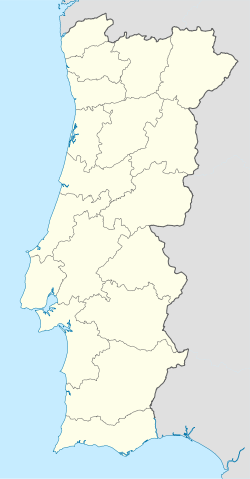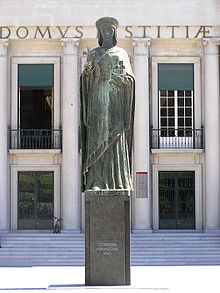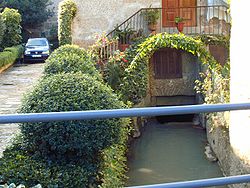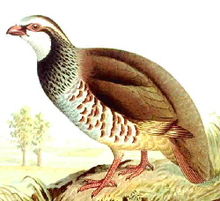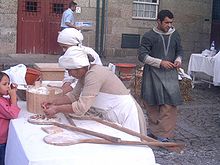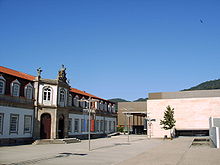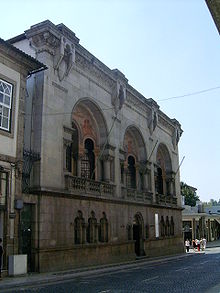- Guimarães
-
For the municipality in Brazil, see Guimarães, Maranhão.
Guimarães — City — Guimarães Castle 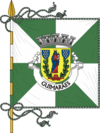
Flag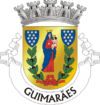
SealCoordinates: 41°27′N 8°18′W / 41.45°N 8.3°W Country  Portugal
PortugalRegion Norte Subregion Ave District Braga Municipality Guimarães City c.1096 Government - Type LAU Area - Land 9.1 sq mi (23.5 km2) Population (2001) - Total 52,181 - Density 5,759.9/sq mi (2,223.9/km2) Demonym Vimaranenses Time zone GMT (UTC0) - Summer (DST) BST (UTC+1) Area code(s) +351 (Portugal) 253 (City) Website www.cm-guimaraes.pt Historic Centre of Guimarães * UNESCO World Heritage Site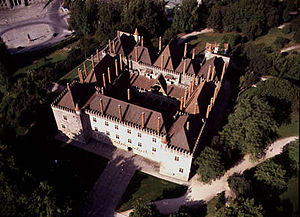
Aerial view of the Palace of the Dukes of Braganza (From IPPAR)Country Portugal Type Cultural Criteria ii, iii, iv Reference 1031 Region ** Europe and North America Inscription history Inscription 2001 (25th Session) * Name as inscribed on World Heritage List
** Region as classified by UNESCOGuimarães (Portuguese pronunciation: [ɡimɐˈɾɐ̃jʃ]) is a Portuguese city located in Braga District, in the North of Portugal and in the Ave Subregion (one of the more industrialized subregions of the country), with a population of 52 181 inhabitants, distributed throughout 20 parishes (freguesia in Portuguese), in an urban area of 23,5 km² with a population density of 2 223,9/km².
It is the seat of a municipality with an area of 241,05 km² and 162 636 inhabitants (2008), divided in 69 parishes. The municipality is bordered to the north by the municipality of Póvoa de Lanhoso, to the east by Fafe, to the south by Felgueiras, Vizela and Santo Tirso, to the west by Vila Nova de Famalicão and the northwest by Braga.
It is an historical city that had an important role in the formation of Portugal and it was settled in the 9th century, at which time it was called Vimaranes. This denomination might have had its origin in the warrior Vímara Peres, when he chose this area as the main government seat for the County of Portugal which he conquered for the Kingdom of Galicia.
Guimarães is one of the most important historical cities of the country. Its historical center is a UNESCO World Heritage Site, making it one of the largest tourist centers in the region.
The city is often referred to as the "birthplace of the Portuguese nationality" or "the cradle city" (Cidade Berço in Portuguese). This might be because the administrative seat of the County of Portugal was established there by Henry of Burgundy, or that it might also been the birthplace of Afonso I of Portugal, the first Portuguese king or because of the historical role of the city in the Battle of São Mamede (June 24th, 1128), which had a tremendous importance in the formation of Portugal and was fought in the vicinity of the city, However, due to the needs of the Reconquista, the governative center was changed to Coimbra in 1129. The "Vimaranenses" are also called "Conquistadores" (the Conquerors) in relation with the historical heritage of the conquest initiated in Guimarães.
Guimarães, jointly with Maribor, is going to be European Capital of Culture in 2012.
Contents
History
The city of Guimarães is historically associated with the foundation and identity of the Portuguese nationality. Guimarães, among other settlements, precedes the foundation of Portugal and because of its role in the foundation of the country it is known as the "cradle of the Portuguese nationality". In 1128, major political and military events that would lead to the independence and the birth of a new nation took place in Guimarães. For this reason, in one of the old towers of the city's old wall it is written "Aqui nasceu Portugal" (Portugal was born here).
Pre and Proto-History
The area in which Guimarães is integrated had permanent settlements since the Chalcolithic. In its municipality this can be witnessed by the Citânia (Castro) of Briteiros and Sabroso and archeologic station of Penha.
The Ara of Trajan hints the use of village of Caldas das Taipas as a spa town by the Romans.
From the foundation of Guimarães to the foundation of Portugal
After the political actions of the Reconquista organized by the Kingdom of Galicia in the 9th century, the medievel foundations of the actual city have roots in the 10th century. At this point, the Countess Mumadona Dias, erected a monestery in her property of Vimaranes, which originated the fixation of people in the area known as "vila baixa" (downtown). At the same time, she ordered the construction of a castle on the hill area which became known as "vila alta" (uptown), to defend the settlement. To connect these to areas the Rua de Santa Maria (St. Maria street) was laid.
The monastery became the "Real Colegiada" (Royal Collegiate church) and throughout time acquired importance due to the privileges and donations given to it by nobles and kings and it became a famous pilgrimage site.
Henry, Count of Portugal approved the first national foral possibly in 1096 (but not confirmed). The foral proves the growing importance of the village of Guimarães at that time, which was chosen as the capital of the County of Portugal.
In the 24th of June of 1128, the "Batalha de São Mamede" (Battle of São Mamede) took place in Guimarães.
Middle Ages
During the reign of the king Denis, as the village was expanding, it was parcially surrounded by defensive wall. In the meanwhile, mendicant orders got settled in Guimarães and helped to mold the shape of the city. Later, during the reign of John I the wall would be tear down and the two parts of the city (uptown and downtown) would be finally united and the city started to expand outside the city walls.
Modern and Contemporany Age
Until the 19th century the structure of the city did not suffer many transformations besides the construction of a few more churches, convents and palaces. It was by the ending of the 19th century that new urbanistic ideas of higiene and symmetry that the village, that was promoted to city by the Queen Maria II in the 23rd of June 1853 had its greatest changes.
The complete tear down of the city walls was authorized and the creation of many streets and avenues could start at that point. The controlled process of urbanization permitted the conservation of the city magnificent historical center.
Geography
Geology
Granite rock formations occupy the majority of the municipality but schist rocks can also be found in certain zones in the northwest of the municipality. On the southeast, clay can be found in stream bed of the Ave, Vizela and Selho rivers.
Orography and Hydrography
The municipality is delimited at north by the "Senhora do Monte" (Senhora hill), at northwest by the hills of Falperra, Sameiro, Outeiro and Penedice. To the south by the Penha hill which with height of 613 meters, it is the highest point of the municipality.
Guimarães is part of the drainage basin of Ave river which divides the municipality in half. The Ave river has as tibutaries the Vizela river, Torto river, Febras river and inside the city, the Selho river, the Couros river and the Santa Lúzia stream.
Climate
Guimarães is located in a valley and surrounded by hills and because there is some distance to the sea, the Winter is normally cold and rainy and the Summer is hot and lightly humid. The average annual temperature is 14º Celsius.
Fauna
There is not much diversity, specially in the urban areas, but the municipallity has some spicies of cynegetic interest such as: the red fox, the wild boar, the turtle dove, the thrush, the pigeon and the red-legged partridge. In the green areas of the city, the most common spicies are rodents and squirrel.
Demographics
In 2001, the population of the municipality was 159 576. In 2010, it is estimated that the population will reach 188 178 inhabitants. The population is constituted by 78 436 males and 81 140 females. Guimarães is the 13th biggest city in the country in terms of population.
- Evolution of the population of the municipality of Guimarães (1801–2008)

- Evolution of the population in the city center (1864–2001)

Culture
Guimarães, is an average size city but with a booming cultural life. Besides its museums, monuments, cultural associations, art galeries and popular festivities, it has since September 2005, an important cultural space, the Vila Flor Cultural Center. This cultural center has two auditories, exposition center and a concert-caffee. Guimarães is getting ready to be European Capital of Culture in 2012, together with Maribor. Until the event, a new Art Platform will be developed in the old market which is expected to be turned into a contemporany art center.
Guimarães was elected by the New York Times one of the 41 places to go in 2011 and NYT called it one of the Iberian peninsula's emerging cultural spots.[1]
Gastronomy
The fact that since its beginning, Guimarães had a feminine monastery made much influence over its regional gastronomy, specially its confectionery. "Tortas de Guimarães" (Guimarães' pies) and "Toucinho do céu" (normally translated as bacon from heaven) are a good example. Besides the customary Minho gastronomy, the so called "meat" cake is made here, which is a kind of bread in a pizza shape served with pig, sardines or other toppings.
Traditions and Festivities
- "Festas Gualterianas" (Gualterianas fest), in honor of Saint Gualter, take place since 1906 in the first weekend of August. The "Cortejo do Linho" (Linen parade) and the "Batalha das Flores" (Battle of the Flowers) are part of the festivities which are ended by the "Marcha Gualteriana" (Gualteriana march).
- "Nicolinas" are the festivities of the students of Guimarães, celebrated in honor of Saint Nicholas. The festivities start on the 29th of November and finish in the 7th of December. They are composed by different celebrations, the "Pinheiro" is the one with most attendancy in which after a dinner in the citys' restaurants, the participants parade the streets of Guimarães playing the "Toques Nicolinos" tune in drums. Latelly, it has been suggested that the "Nicolinas" should be contendent to be UNESCO intangible cultural heritage.
- The Santa Luzia festivities in honor of honor Saint Lucy take place annually in the 13th of December, near to the chapel of Santa Luzia. The selling of traditional cakes made of rye and sugar, which are called "Sardão" and "Passarinha" (these names have sexual connotations in Portuguese). According to the tradition, a boy should offer a "Sardão", which has a phallic form, to the girl and if the girl was interested in dating the boy, she should retribute with a "Passarinha".
- The "Big Romaria of São Torcato", it is one of the biggest romarias in Minho, takes place annually in July in the village of São Torcato.
Museums, cultural spaces and art galeries
The city of Guimarães has several cultural spaces of reference at a regional and national level. Among the several museums of the city, the Alberto Sampaio museum is the one that stands out. Founded in 1928 and opened its doors to the public in 1931 it is located in the old site of the Canon the Collegiate of Our Lady of Oliveira (Cabido da Colegiada de Nossa Senhora da Oliveira in Portuguese). It contains a rich collection of pieces from the 14th, 15th and 16th century, including one rare vest that used by the king John I.
The Martins Sarmento Society (Sociedade Martins Sarmento in Portuguese) is one of the country oldest institutions dedicated to the study and preservation of archaeological artifacts. The society owns two museums: the Archaeological Museum of the Martins Sarmento Society, which is known by its prehistory and protohistory collections and also its numismatics and epigraphy collections; and the Castro Culture Museum which is dedicated to the castro culture.
There is also: the Primitive Modern Arts Museum, located in the Dommus Municipallis (the old city hall), which contains a collection of naïve art; the Museum of the Village of São Torcato, which is dedicated to the region and its relationship with the monastery and Saint Torcato (São Torcato in Portuguese); the Agriculture Museum of Fermentões, which exhibits collections of the traditional agricultural practices of the region; and the Museum of São Sebastião, inaugurated on 24 March 1984, which estate is constituted majorly by sacred art.
Other cultural venues include:
- Vila Flor Cultural Center (Centro Cultural Vila Flor in Portuguese) is the main cultural venue in Guimarães. It was built in 2005, in a recovery of the old Vila Flor Palace and its surrounding area. It has two [Auditorium|auditoriums], a concert-cafe and a exhibition gallery. The surrounding gardens of the old palace were also redone and in 2006, received an honorable mention in the Public Exterior Spaces category in the National Landscape Architecture Award.
- São Mamede - Guimarães Arts and Shows Center.
- Raul Brandão Municipal Library has its headquarters in the city and also has branches in Pevidém, Caldas das Taipas and Ronfe. It offers its mobile library services to 42 parishes and services the city schools and prison.
- The Art Laboratory (Laboratorio das Artes in Portuguese) was founded in 2004 by ESAP students. It is a cultural space for exhibitions, performances, music and art workshops.
- Alfredo Pimenta National Archive, founded in 1931, contains the archives for municipality of Guimarães and also the Braga district.
Society
In 2008, the city ranked second in the index of most livable city in Portugal. It is also the second less polluted city in the country.
In 2004, 89% of the population had running water, it was forecast that the number would raise to 95% by 2006. In 2001, 63.5% of the population had basic sanitation, it was forecast that the number would raise to 80% by 2008. In 2001, 100% of the population had access waste management services.
However, several people complain that the city, together with other cities of the Braga district has had a unaesthetic and unorganized growth.
Social media
Newspapers
Guimarães is the forth city in the country with more available newspapers. The oldest one was the "Azemel Vimaranense" was founded in 1822 and possibly had its publication halted by the Vilafrancada incidents. From 1856, other newspapers start to appear, amongst them "A Tesoura de Guimarães". Actually the citys' newspapers are:
- O Comércio de Guimarães
- O Cónego
- O Conquistador
- Desportivo de Guimarães
- Entrevillas
- O Expresso do Ave
- Jornal do Adepto
- Lordelo Jornal
- O Pilar
- O Povo de Guimarães
- Notícias de Guimarães
- Reflexo – O Espelho das Taipas
- Sport Jornal dos Desportos
Radios
There are two cities with headquarters in the city, Fundação Radio (95.8 FM) and the Santiago Radio (98.0 FM).
Television
The Guimarães TV transmission is made online since 24 July 2007, it is the result of a collaboration between the citys' assembly and the Guimarães Cybercenter. Its contents are feature in the Região Norte TV channel which is available through cable.
The "canalguimarães" is another online channel that started operating in March 2010. It is the fruit of the effort put in by an arts association, the "Associação de Socorros Mútuos Artística Vimaranense", one of the oldest associations of the city.
Sister relationships
Guimarães has the following sister cities:
 Pleven, Bulgaria;
Pleven, Bulgaria; Londrina, Brazil;
Londrina, Brazil; Mé-Zóchi, São Tomé and Príncipe;
Mé-Zóchi, São Tomé and Príncipe; Brive-la-Gaillarde, France;
Brive-la-Gaillarde, France; Igualada, Spain;
Igualada, Spain; Tacoronte, Spain;
Tacoronte, Spain; Rio de Janeiro, Brazil;
Rio de Janeiro, Brazil; Kaiserslautern, Germany;
Kaiserslautern, Germany; Colônia do Sacramento, Uruguay;
Colônia do Sacramento, Uruguay; Compiègne, France;
Compiègne, France; Tourcoing, France;
Tourcoing, France; Ribeira Grande de Santiago, Cape Verde.
Ribeira Grande de Santiago, Cape Verde.
References
Coordinates: 41°27′N 8°18′W / 41.45°N 8.3°W
30 largest cities of Portugal by population Lisbon · Porto · Amadora · Almada · Odivelas · Vila Nova de Gaia · Agualva-Cacém · Queluz · Braga · Coimbra · Funchal · Setúbal · Aveiro · Guimarães · Rio Tinto · Viseu · Ponta Delgada · Matosinhos · Amora · Leiria · Faro · Évora · Barreiro · Póvoa de Varzim · Ermesinde · Viana do Castelo · Maia · Covilhã · Portimão · Castelo Branco
European Capitals of Culture 1985 Athens · 1986 Florence · 1987 Amsterdam · 1988 West Berlin · 1989 Paris · 1990 Glasgow · 1991 Dublin · 1992 Madrid · 1993 Antwerp · 1994 Lisbon · 1995 Luxembourg City · 1996 Copenhagen · 1997 Thessaloniki · London 1998 Stockholm · 1999 Weimar · 2000 Reykjavík · Bergen · Helsinki · Brussels · Prague · Kraków · Santiago de Compostela · Avignon · Bologna · 2001 Rotterdam · Porto · 2002 Bruges · Salamanca · 2003 Graz · 2004 Genoa · Lille · 2005 Cork · 2006 Patras · 2007 Luxembourg City and Greater Region · Sibiu · 2008 Liverpool · Stavanger · 2009 Linz · Vilnius · 2010 Essen · Istanbul · Pécs · 2011 Turku · Tallinn · 2012 Maribor · Guimarães · 2013 Košice · Marseille · 2014 Umeå · Riga · 2015 Mons · Plzeň · 2016 San Sebastián · Wrocław
World Heritage Sites in Portugal Norte Alto Douro Wine Region · Historic Centre of Guimarães · Historic Centre of Porto · Prehistoric Rock-Art Sites in the Côa Valley and Siega Verde1
Centro Lisboa Cultural Landscape of Sintra · Monastery of the Hieronymites and Belém Tower, Lisbon
Alentejo Historic Centre of Évora
Azores Madeira 1 Shared with other region/s and Spain Categories:- Geography articles needing translation from Portuguese Wikipedia
- Cities in Portugal
- World Heritage Sites in Portugal
- European Capitals of Culture
Wikimedia Foundation. 2010.


